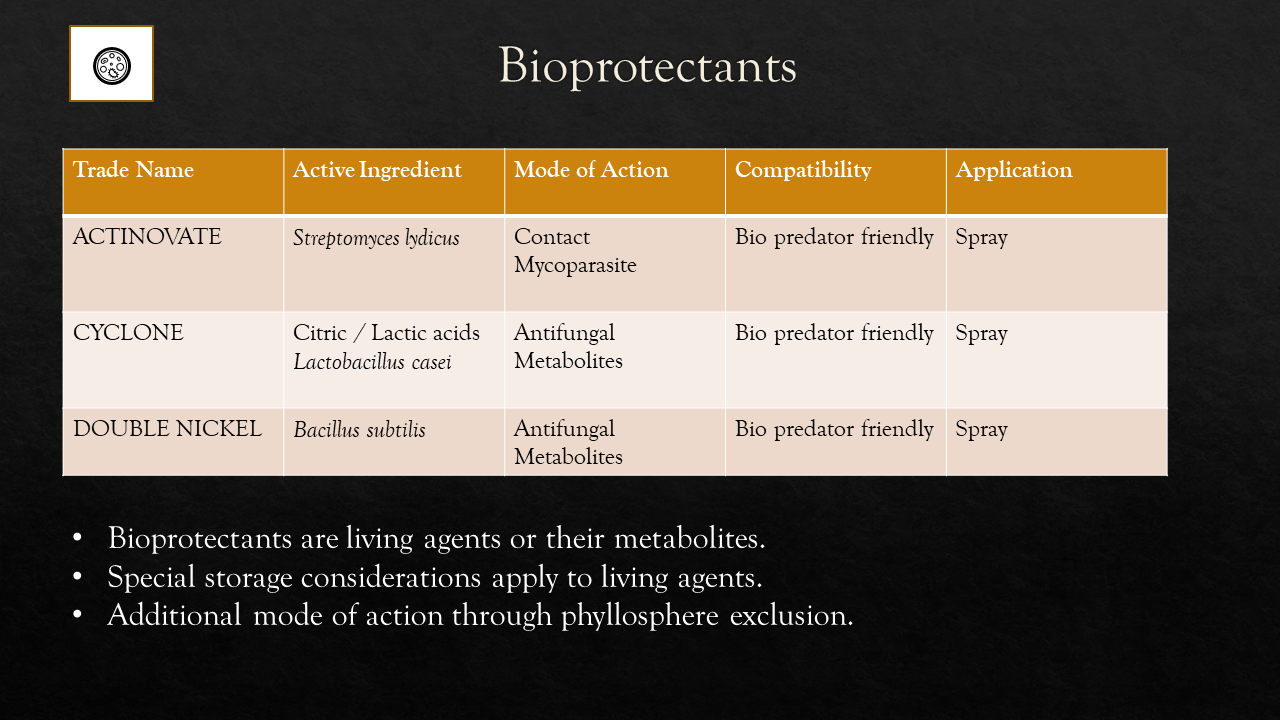Treat Powdery Mildew to Protect Your Cannabis Crop
Powdery mildew disease is responsible for the destruction of billions of dollars’ worth of cannabis every year.
The systemic fungicides used to treat this disease in other crops are not approved for use on cannabis for human safety reasons.
Chemical residues which can be washed from fruits prior to consumption, often remain in cannabis flowers, and sometimes convert into more toxic compounds when combusted.
Fortunately, Powdery Mildew (PM) disease can be managed without the use of systemic pesticides if you are willing to put in the work required to understand this pathogen, and to disrupt the conditions that favor its multiplication.
What is Powdery Mildew?
Powdery mildew is a plant disease caused by biotrophic fungal pathogens.
These pathogens colonize their plant hosts for the acquisition of nutrients, in the form of photosynthates. Powdery Mildew pathogens are host-specific, with different variants infecting various plant species. At least 850 PM variants have been characterized to date.
Plant infection is initiated when spores or conidia establish on the surface of a susceptible plant host. Under favorable conditions (for the pathogen) the conidia will germinate, and a haustaria will form and penetrate the plant epidermis.
The hausteria structure enables the pathogen to acquire nutrients from the host in the form of photosynthates, to the detriment of plant performance. When conditions permit, sporulation, or mycelial growth on plant surfaces will occur, forming conidia which are then dispersed to complete the cycle of disease pathology.
Powdery Mildew Identification
The sporulation feature of the pathogen life cycle is visually evident on crop surfaces, having a fuzzy mildew appearance. This aspect of the developmental cycle is the most destructive to cannabis yields and quality. Sporulation usually occurs first in areas with stagnant airflow, often within the understory of the crop.
A holistic approach is required to manage disease pressures without the use of chemical pesticides.
Physical, Chemical, and Biological treatments must be choreographed to optimize efficacy.
Treatment programs must be continually evaluated for efficacy, and improved based on data acquired during weekly scouting and mapping of pest pressure intensity.
Early identification is required for proactive pest management. All crop workers should be trained to identify and report common plant diseases.
Some Pest Control Products can have detrimental impacts on biocontrols, and crop treatments should be closely coordinated.
Three Factors Enable Disease development
Each factor represents an opportunity to interrupt disease development.
The PM species that have been implicated in PM infections in Cannabis crops are P macularis, and G ambrosiae.
These are not the same PM pathogens that commonly infect other plant species including cucurbits like squash.
The host specific nature of PM pathogens means that they are not endemic, or universally present, and can sometimes be excluded from protected environments.
Pathogen exclusion requires following biosecurity protocols to eliminate potential pathogen vectors.
For most large-scale operations constant PM pressure should be assumed, and proactive treatments applied. The most common disease vectors for PM pathogens are live plants that are imported into production facilities.
Biosecurity
Due to its ability to live within plant tissues, Powdery Mildew disease can be very difficult to diagnose and eliminate, even with rigorous quarantine procedures.
Best practice entails not bringing live plants into a clean facility. It is much safer to bring in biological starting materials in the form of seeds, or as plantlets.
Plantlets are plants which have been cultured within in vitro (in glass) sterile environments.
This process is effective in excluding pathogens, and in some cases can be used to eliminate plant viruses.
Many indoor facilities operate within sealed environments, and pathogens can be very effectively excluded by air lock, and air filtration practices.
Air filtration usually involves a two-step system where a filter of MERV-13 rating or better is used to remove particulates. The second step is a downstream UV light treatment to kill any spores that remain in the air column.
In greenhouses, which require high rates of air exchange to manage climate factors, the complete exclusion of airborne pathogens through air filtration is unrealistic.
Cannabis plants vary greatly in their resistance to Powdery Mildew disease.
Most commercial cultivars exhibit some susceptibility to this infliction, with broad leaf varietals particularly affected.
Fortunately a resistance gene has recently been characterized that confers immunity to the G Ambrosia strain implicated in many PM infections.
This PM1 gene is dominantly inherited, enabling it to be ingressed into hybrid cultivars within reasonable time frames.
Genetic resistance traits can be dynamic, as pathogens evolve to accommodate their hosts acquired defenses. A specific cultivar’s susceptibility to PM disease can be verified through trials prior to large scale production. Healthy plants are better able to fend off pathogens through a robust immune response.
Stress Priming
Plants have evolved immune responses to respond to pathogens with chemical defense systems.
Plant immune responses can be activated by Stress Priming.
This refers to a crops ability to quickly respond to a stressor that it has been exposed to in the past. This is similar to a vaccine immune response.
Hormone signaling systems are commonly targeted for this purpose.
An example of stress priming for PM management in cannabis plants is the use of plant-based pesticides like Regalia to initiate plant defenses.
This product stimulates the ISR and SAR plant immune systems through interaction with phytohormones including Jasmonic acid, and Salycilic acid.
These hormones signal to the plant that it is under pathogen attack and enable a protective immune response.
Powdery Mildew, in contrast to other common fungal plant pathogens, can proliferate in a variety of environmental conditions.
In CEA, the same temperature and humidity conditions which enable plant productivity are conductive to the reproduction of PM pathogens.
Large humidity and temperature fluctuations can contribute to the cycle of germination to sporulation.
In addition to maintaining a stable climate, the most important controlled climate factor that we can regulate to minimize the spread of PM is airflow efficiency.
As cultivators we understand the critical importance of climate on plant performance. Laminar airflow allows us to keep the entire crop within the closest possible range to our climate targets.
Airflow Efficiency
Airflow efficiency, or laminar airflow describes the smooth organized flow of air. In this state, layers of air slide past each other without creating turbulence at the interface.
There are several factors that serve to establish laminar airflow cells including location and orientation of air movement equipment, velocity of air being moved, and physical barriers to airflow.
Laminar airflow equalizes the grow climate and eliminates turbulence and stagnant air conditions which favour establishment and germination of PM conidia.
Laminar airflow within cultivation environments is optimized through the establishment of Horizontal Air Flow (HAF) cells.
The size of these HAF cells can vary depending on the facility, but the path extends for the length of the facility and is usually no more that 20 feet wide to ensure air movement throughout the crop.
Vertical air mix fans are usually located along the center of these cells to limit vertical stratification of the environment without interrupting the horizontal airflow.
Laminar airflow also has a direct benefit to photosynthetic efficiency.
When plants are photosynthesizing, in areas lacking proper air movement, microclimates called leaf boundary areas can quickly form at the underside of each leaf blade. This microclimate becomes humid, and co2 depleted as the stomata exchange water vapor and oxygen for co2.
This boundary area makes gas exchange less efficient and limits photosynthetic potential. Proper airflow will minimize leaf boundary areas as well as other microclimates. Spray applications, and Sulfur vaporization are also more uniformly distributed in a laminar airflow environment.
Pruning and thinning of Cannabis crops also helps to optimize airflow dynamics. Many of the leaves and flower sites in the understory of a thick Cannabis crop do not receive enough light to form dense inflorescences, and removal of these plant parts can aid in airflow through the crop.
Pest Control Products
Management of PM in production environments often requires the application of Pest Control Products.
While most systemic fungicides are not permitted for use on cannabis, there are several classes of safer pesticides that have shown efficacy in managing Powdery Mildew disease.
You must always ensure that the product being applied is registered for use on cannabis in your jurisdiction, and that all label requirements are followed.
There are a several effective fungicides that can be used during the vegetative stage which are compatible with most jurisdictional regulations.
Safer Pesticides
Horticultural Oils
Pesticidal Soaps
Sulphur
Potassium Bicarbonate
Immune System Stimulants
Bioprotectants
H2O2
These products are safe to use only when all Label Requirements are followed. Some treatments can be detrimental to BioPredator populations.
As flowers form, many of the tools used to control PM are no longer appropriate. Some products are safe to spray during this period but spraying flowering plants can cause elevated humidity within the inflorescence, increasing the possibility of Botrytis establishment.



















